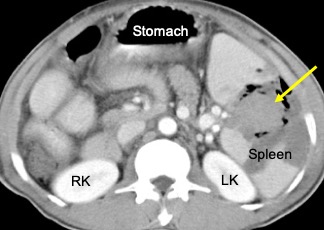Case contribution: Dr Radhiana Hassan
Clinical:
- A 43 years old man
- History of fall from motorbike about one week ago. Described as low impact injury but he fall with handle of motorbike hit left side of abdomen.
- Having abdominal pain since then which gradually increased in severity.
- BP=128/72 mmHg, PR=88 bpm, GCS=15/15.
- Clinically tender at left hypochondriac region.
- Hb= 11.8 gm/dL and TWBC= 13.4

CT scan findings:
- The spleen is enlarged. Area of hypodensity within the spleen measuring about 6 cm.
- Multiple air pockets are seen within the hypodensity (yellow arrow)
- Minimal perisplenic collection seen.
- No active contrast extravasation.
- Other organs are normal.
Intra-operative findings:
- Large spleen with abscess at midpole.
- Splenic capsule is intact. Gas bubbles seen in the spleen.
- Minimal hemoperitoneum.
- Other organs are normal.
Progress of patient:
- Initially patient was treated conservatively and planned for percutaneous drainage.
- However he developed sepsis during admission and open laparotomy done (findings as above).
- Post operatively noted to have persistent ascitic fluid through drainage tube
- Blood investigation shows Hepatitis C +ve.
- Discharged well after 20 days in ward.
Discussion:
- Missed splenic injury is the most common cause of preventable death after blunt abdominal trauma
- Among previously reported complications of blunt splenic injury are missed splenic injury, delayed rupture, the development of a splenic pseudocyst, liquefaction and infection.
- Delayed splenic rupture was first described in 1902 with its occurrence 48 hours after trauma. The incidence is approximately 1%, and it tends to occur between 4 and 8 days after injury. Potential mechanisms include expansion of a subcapsular hematoma, clot disruption, or rupture of a pseudoaneurysm or splenic pseudocyst.
- Prompt recognition of the signs and symptoms of complications of splenic injury is essential for better patient care.
